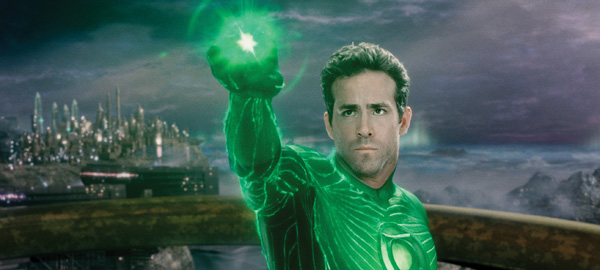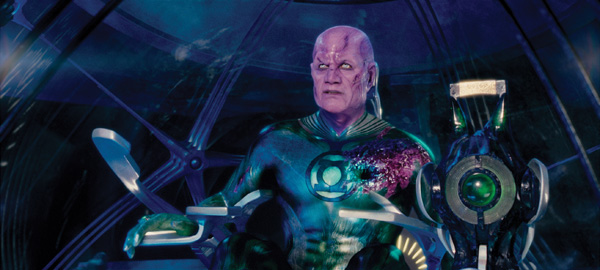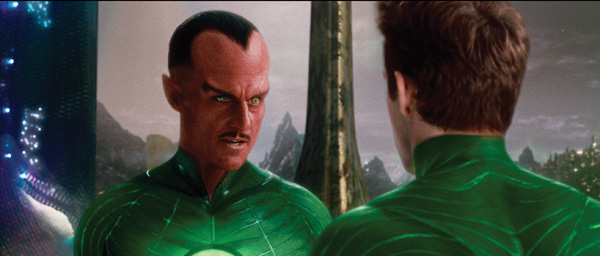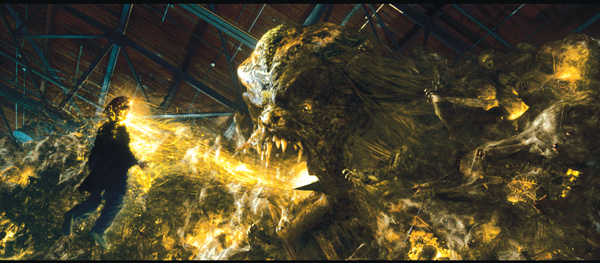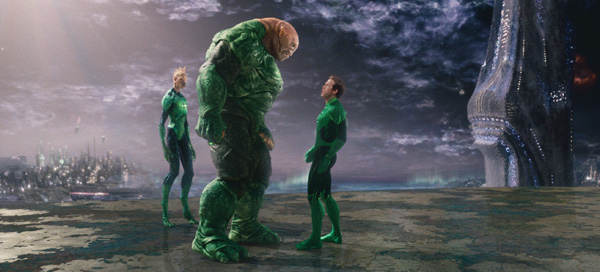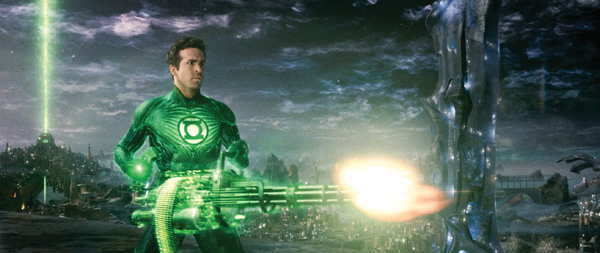| Senior Animation Supervisor David Schaub at Sony Pictures Imageworks explained that the overriding theme for ‘Green Lantern’ – from writers, thedirectorand producers to the production designer, VFX teams and animators - was authenticity. 'Green Lantern' goes back over 70 years, evolving over time and gaining a passionate fan base. It was important not to re-invent any details.
Authentic Fantasy
The story focuses on how the lead character Hal Jordan became a Lantern, the sole human among the 3,600-strong corp of Green Lanterns who each represent different sectors of the galaxy comprising vast worlds and environments. Director Martin Campbell, typically a live action-oriented director, wanted the VFX for ‘Green Lantern’ to work with the live action inside a coherent world. His vision was a challenge, given the other-worldly quality of these alien environments.
SPI handled about 1,000 of the film’s 1,500 shots under VFX Supervisor Jim Berney, focusing on Hal Jordan and the principle alien superhero characters Sinestro, Abin Sur, Tomar-Re and Kilowog. The team’s work becomes evident after Hal’s transformation into a Lantern on the planet Oa, and their most challenging task was replacing the bodies of three of the heroes with skin-like, full-body digital suits while preserving the photographic elements of their heads and their complete performances as they were in the plates.
Hybrid History
The groundwork for achieving this kind of hybrid character was first established at SPI when the company was working on ‘Alice in Wonderland’. The character Stayne was developed through a process of animating the actor’s body underneath a stabilized photographic head. However, unlike Stayne’s bulky suit of armour with a large, forgiving collar to hide the transition between elements, the Lanterns’ form fitting suits required a precise skin-to-skin alignment between the photography and the CG body, creating a much more difficult challenge.
The reason for going to this extra effort was to give the super heroes the essential characteristics in the Green Lantern suits with their subsurface glow and organic sculpted design, created by costume designer Ngila Dickson, within which the animators needed to enhance muscle performances with secondary animation, bringing the character to life in an organic way. David said, “Under the sculpted silhouette of the suit was the visible musculature, sliding below the surface. The basis of each suit was a rig, like any animated character. Because Hal’s live action head element sits in a very specific place in the frame, the body had to be precisely tracked to the head, working with this rig.”
Core Animation
The process was different to motion capture, achieved with an array of cameras positioned at myriad angles, shooting actors covered in infrared tracking markers and converting the signals into motion data. For ‘Green Lantern’ the tracking was either done by hand through rotomating, or optically using rego marks on the suit and views from four witness cameras shooting from different angles, which the tracking software uses as photo reference for the character’s position.
“Because the centre of gravity was effectively shifted from the pelvis to the neckline, tracking was used to accurately lock down the actor’s ‘core’ animation – everything from the pelvis up into the neck. That task represented about 70 percent of the job. Then the animators took over to animate the limbs and push performances of those elements where necessary, as long as the core animation was locked and never touched,” said David.
Blend Point
The next step was the critical animation of the neck, which involved a complex system of deformers that the animators used to integrate the neck into what is seen in the plate. On set the actors wore very small tracking markers, set up to show the animators exactly where the neck was in any given frame, and the deformers were used to manipulate the model to conform to the photography. The neck itself has a huge number and variety of muscles that come into play whenever the actor speaks and breathes, requiring a further set of deformers animated with great finesse to make the movement believable and organic.
“The neck was the critical blend-point between the actor and the digital suit. Animators were given extensive controls over the muscles in this area – not only for shape and volume, but also translational control over attachment points for the mastoid muscles of the neck,” David said. “It seems odd that we would need to translate the muscle positions, but at times muscles just didn’t line up the way they should when viewed from certain angles. Once we locked down the muscle deformations in the neck, the animators had more freedom to accentuate and exaggerate the muscles artistically throughout the rest of the body.”
Muscle Library
The muscle deformers played a major role in bringing authenticity to the look of the suit. With Hal, two other superheroes, Sinestro and Abin Sur, were created through the same tracking-and-integration process. Sinestro’s neckline was more challenging because of the muscle and tendon movement in actor Mark Strong’s neck when he speaks and moves. Creatively, most of the animation work on the hybrid characters was the secondary animation, a critical step that made them feel organic and real instead of stiff and mannequin-like.
“Unfortunately, the visual cues we hoped for in Ryan Reynolds’ performances as Hal were not as accessible as we would have liked. He was wearing a grey spandex suit covered in optical tracking markers, and very little muscle definition could be discerned under the costume. Instead, animators relied on muscle references that I shot of one of our lead animators with a body builder’s physique. We put together an extensive video library of muscles flexing and deforming under different conditions, and this became our guide.”
Rig Evolution
The rigging team provided the necessary deformers and controls to engage the muscles in all the critical areas of the body. “Because muscle volumes inflate, and also pull, lift and sag under different conditions, the muscles need to be sculpted and animated by hand to match our muscle reference,” explained David.
“It really isn’t practical to drive muscle shapes as a function of joint rotations in this case, because muscle movement often anticipates the action. When a character rises up on his toes, there is a firing, inflating and upward pull of the calf muscles in three distinct stages. It just isn’t practical to hard code this anticipatory action into the rig. A shot-finalling team, consisting of technical animators with a rigging background, put the finishing touches on many shots, plus the odd ones that required new deformers and unique muscle shapes not attainable with the existing controls. If it looked like a recurring shape that could be used in other shots, it was rolled into the rig. It was an ever-evolving entity.”
The animators learned how far they needed to push muscle deformations while still working well with the surface texture, similar to dolphin skin. The team also had a system to control muscle jiggle. Even the most subdued walk causes muscles to jiggle with each step. The animators fixated on such analysis over the course of the film. The muscles deform in a recognisable way that viewers are subliminally aware of – especially when it is missing.
|
CG Alternative
Because the tracking, animation and integration was labour-intensive, they looked for opportunities to avoid tracking and render a fully animated character. For example, shots in which the character was any distance from the camera or viewers only see the back of his head were good candidates for an all-CG character. These were also a chance to enhance the performances since the animators were not locked into predefined movements of the actor. Performances could be creatively keyframed any time the Lantern flies or performs super-hero stunts.
The all-CG characters like Tomar-Re and Kilowog were rigged and animated conventionally, with a voice track to work with instead of the live actor’s head locked into the plate. Stand-in actors were used on set aseyelinereference for these CG heroes and served as stage partners for better integration of real and CG characters. Kilowog stands eight feet tall and needed a stand-in actor on stilts to correctly align the performances.
Lanterns in Flight
The production artwork and comic book imagery indicated what Martin was after for the Lanterns in flight. “Beyond the classic hero poses, the flight styles had to reflect the characters’ personalities,” said David. “Over time we developed unique flight characteristics for each hero Lantern. For example, Tomar-Re is elegant and poised and so his flight characteristics are graceful and fluid. I came across some great reference of underwater ballet for the way Tomar manoeuvres through space.
“Since Hal Jordan was new to all of this, his first attempts at flight were a little clumsy. Once he became more experienced, his flight characteristics became an extension of who he was – a fighter pilot. We looked at a lot of F16 jet-fighter reference and specifically emulated moves that Martin had already directed in the dog-fight sequence created at Rising Sun Pictures.”
Once the stand-ins were painted out, the animators could proceed as they do for any animated film, using the proper actors’ voice tracks. From that stage, combining the hybrid and all-CG characters in the same frame became the compositors’ job, as much as combining CG and live action within the same character. Due to the suit’s hyper-real green glow and skin-like quality, the risk of a dramatic disconnect was always there. Casting a slight greenish light, for example, up onto the real actor’s face was important to integration.
Super Villain
Parallax is the film’s ‘super villain’ that roams from planet to planet through the galaxy as an amorphous yellow cloud, sucking the souls from the inhabitants. It feeds on their fear, symbolized by its yellow colour. Composed of these tortured souls, Parallax evolves and grows organically, and created a serious and interesting animation challenge for the team.
Interpreting it from the concept artwork into an animated creature required knowing how it was going to move. At first look, it resembles a fluid simulation, flowing and spilling into the city in the story. In the early stages, in fact, director Martin Campbell described it as an avalanche out of which the souls are trying to claw their way through a membrane, but using fluid simulations gave a result that was too close to a real avalanche or mudslide pouring into the city. The essential factor was giving it a form of intelligence, which in turn let it become a more directable animation challenge.
A system of tubes, each driven by an internal spline curve with IK handles, was devised for the animators to direct the performance precisely, giving Parallax the necessary ‘purpose’ and intelligent quality, allowing small branches of it to reach out, search and pursue victims. This system became the animation team’s underlying backbone upon which everything else was layered.
Layered Approach
“We could animate the volume of the tube locally along its length, with twist controls,” David explained. “Eventually, effects could be populated into these volumes, with the basic shape and movement of that volume defined in animation. They were our fundamental building blocks. Obviously we didn’t want Parallax to look like a tube, so by lumping a system of tubes together, overlapping and twisting, we could create larger volumes of whatever shape we desired. The more complex the interweaving of tubes, the more interesting the rendered result, especially when each tube was moving uniquely within the cluster. We thought of it as a big ball of spaghetti – or a bucket of maggots, as Martin suggested.”
Complexity was added with a layered approach. The effects team focused on methods for rendering the many layers of internal fibres, hair strips, connective tissue and external webbing depicted in the concept paintings. The mass of tortured souls, with randomly assigned animation cycles, would be placed inside the tubes through instancing in Massive. The artists would then layer cloth and other simulations on top of that foundation to achieve the roiling effect from within. Instead of creating a simulation-driven object, animation was used to drive Parallax as a character.
Selling the Scale
Scale was another issue for the effects team, changing constantly as the character morphs into different forms, chasing its victim down corridors, through the streets, devouring an entire city or an entire planet. The speed of the animation and simulations also had to be adjusted constantly to help sell the scale in each scenario. Adjusting the elements to make the scale believable from shot to shot was less a matter of hard science than artistic judgment.
The two systems, animation and effects, were closely linked and required collaboration. The animation would proceed through a sequence until it reached a point where the animators needed to render and see what they had achieved, combined with the effects. “Getting feedback from the rendered result out of FX allowed us to focus on specific areas without overworking areas that would never be seen. The effects team would then respond by adjusting the parameters to impart the correct fluid quality to the simulation,” said David.
Effects and Animation
“The project was unusual in having the effects and animation teams working so closely in parallel instead of one group following the other. The conventional creature animation pipeline runs from animation to cloth, hair, lighting and so on, but for ‘Green Lantern’, such processes more often ran in a circular pattern until the whole system of looks and moves was right. Quick turnaround from all departments was necessary for this to succeed. Once the fundamental movement of tube pods was approved - for the first round - the animation was moved forward to FX where massive agents and complex simulations were added as layers to the animated structure.”
The animation team produced a library of different animation cycles for the tortured souls populating the massive system. Different levels of intensity were required in the animation – crazed and frenetic for the attack on the city, then slow and creepy for the scene inside the hangar. The effects team applied the generic animations to an assortment of alien body-types in the final render.
Once rendered, the natural looking movement of the roiling fluid mass inside of and on top of the animated volumes often inspired further animation. David said, “For example, if mass of souls collides with a building in the scene, a natural simulation event might occur. Rather than simply letting the mass dynamically fall with gravity, a new pod could spawn from inside that mass and take on an intelligent life of its own – shooting around a corner to go after another victim. It was an interactive process, specific to this kind of character.
|

